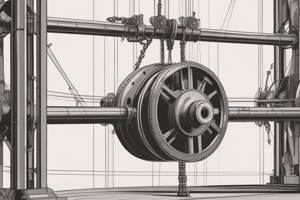Podcast
Questions and Answers
What is the primary function of a simple machine?
What is the primary function of a simple machine?
- To change the direction or magnitude of a force (correct)
- To generate more energy
- To increase the speed of an object
- To reduce the weight of an object
What type of simple machine is used to split, lift, or separate objects?
What type of simple machine is used to split, lift, or separate objects?
- Screw
- Wedge (correct)
- Inclined plane
- Lever
What is the term for the ratio of output force to input force in a simple machine?
What is the term for the ratio of output force to input force in a simple machine?
- Force multiplication
- Energy efficiency
- Torque ratio
- Mechanical advantage (correct)
What type of simple machine is used to convert rotary motion into linear motion?
What type of simple machine is used to convert rotary motion into linear motion?
What is the ability of a simple machine to increase the force applied to it, making it easier to lift or move objects?
What is the ability of a simple machine to increase the force applied to it, making it easier to lift or move objects?
What type of simple machine is used to reduce friction and change direction?
What type of simple machine is used to reduce friction and change direction?
Flashcards are hidden until you start studying
Study Notes
Definition and Overview
- A simple machine is a device that changes the direction or magnitude of a force, making it easier to lift, move, or manipulate objects.
- There are six types of simple machines: inclined plane, lever, wedge, screw, wheel and axle, and pulley.
The Six Types of Simple Machines
1. Inclined Plane
- A flat surface that is tilted at an angle, used to lift or move objects to a higher or lower position.
- Examples: ramps, stairs, ladders.
2. Lever
- A rigid bar or beam that pivots around a fixed point, used to apply force in a different direction.
- Examples: seesaws, crowbars, door handles.
3. Wedge
- A triangular-shaped object used to split, lift, or separate objects.
- Examples: axes, knives, scissors.
4. Screw
- A cylindrical object with a spiral ridge, used to convert rotary motion into linear motion.
- Examples: screws, bolts, jar lids.
5. Wheel and Axle
- A circular object that rotates around a fixed axis, used to reduce friction and change direction.
- Examples: bicycles, cars, gears.
6. Pulley
- A wheel with a grooved rim and a rope or cable wrapped around it, used to change direction or lift objects.
- Examples: elevators, cranes, block and tackle.
Key Concepts
- Mechanical advantage: the ratio of output force to input force, which determines the machine's efficiency.
- Force multiplication: the ability of a simple machine to increase the force applied to it, making it easier to lift or move objects.
- Work and energy: simple machines can change the direction or magnitude of a force, but cannot create energy, only convert it from one form to another.
Studying That Suits You
Use AI to generate personalized quizzes and flashcards to suit your learning preferences.




